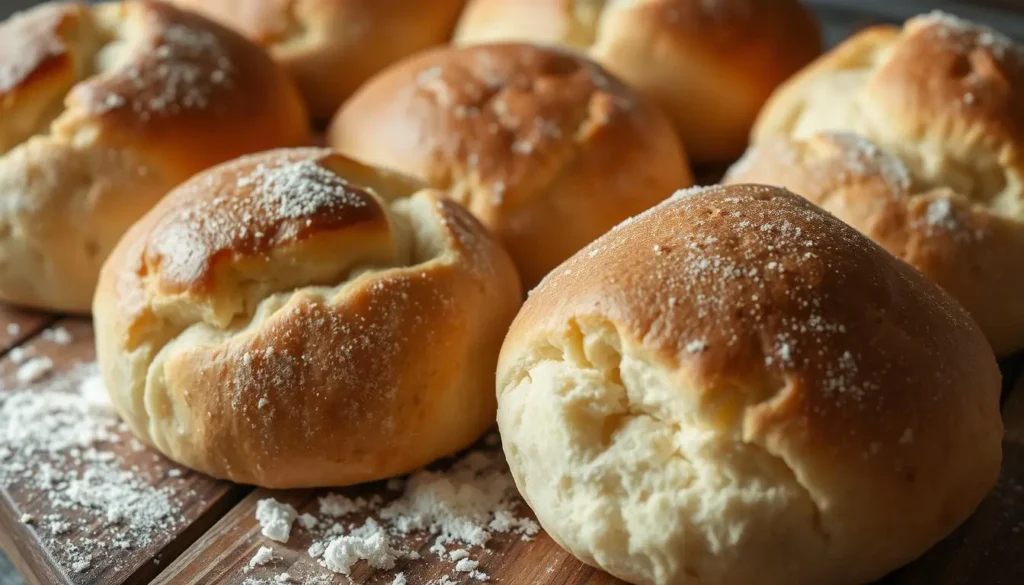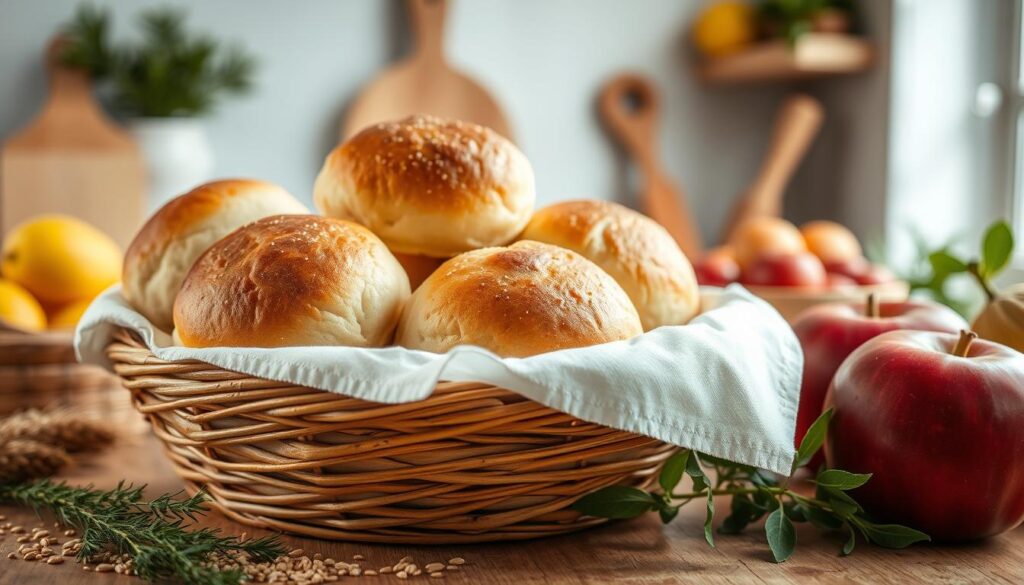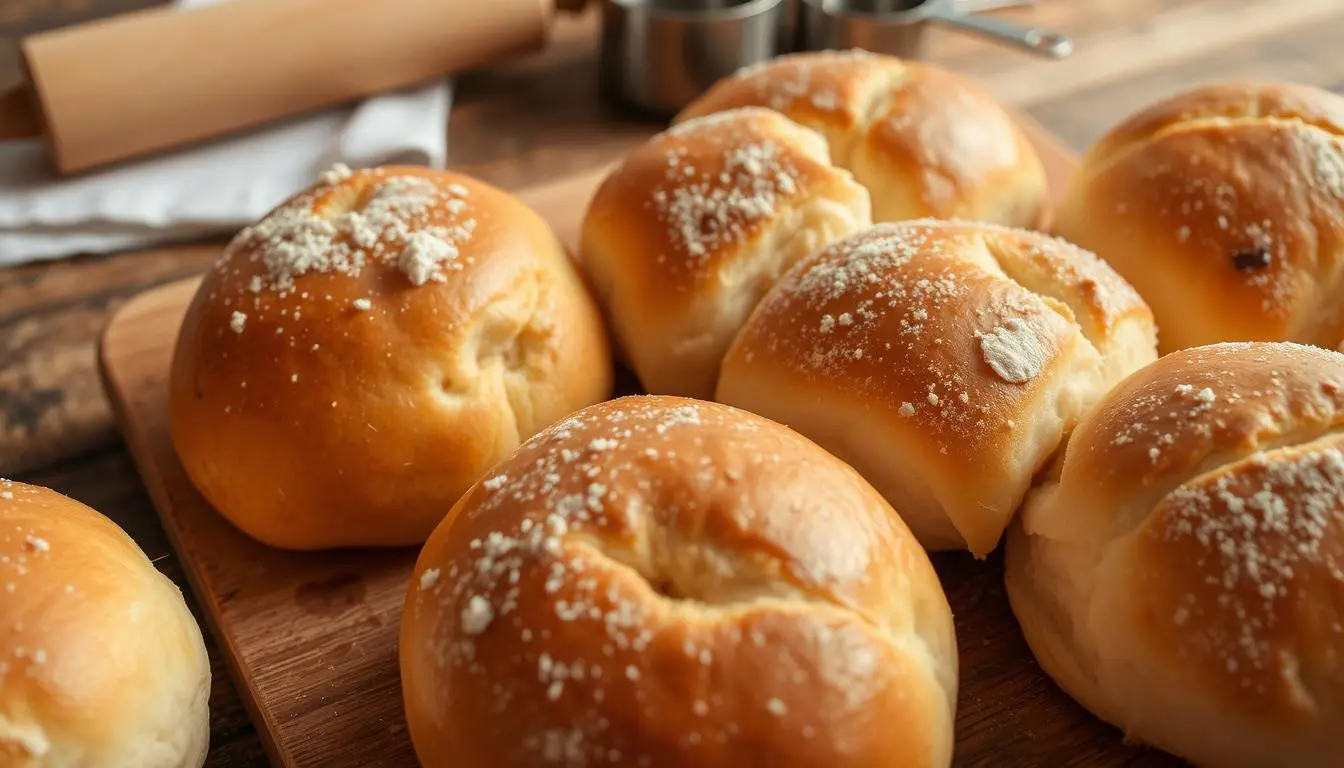Table of Contents
There’s something incredibly comforting about the smell of fresh bread wafting through your kitchen, isn’t there? As you knead the dough, it becomes a kind of therapy—a moment to escape the chaos of daily life. You can just picture yourself gathering around the table with loved ones, eagerly tearing into warm, homemade sourdough rolls.
These aren’t just any rolls; they’re soft and fluffy sourdough dinner rolls that bring a touch of love and warmth to every meal. In this guide, you’ll not only learn how to create the best sourdough dinner rolls but also discover the special ingredients and techniques that make them truly irresistible. So, roll up your sleeves, and let’s embark on this delicious journey together.

Introduction to Sourdough Dinner Rolls
Sourdough dinner rolls are a hit among home bakers. They offer a unique flavor and texture. Unlike classic dinner rolls, they have a sour tang from the sourdough starter.
These rolls are great for any occasion, from holidays to family dinners. They pair well with many dishes, like meat and soups. Their crispy crust and soft inside make them enjoyable all year.
Making easy sourdough dinner rolls might seem hard, but it’s worth it. You’ll get delicious results that everyone will love. With the right skills and patience, you can make amazing sourdough rolls.
What Makes Sourdough Dinner Rolls Special?
Sourdough dinner rolls are special because of their unique taste and texture. They have a mix of sweet and tangy flavors. This makes them great for any meal.
Their golden-brown crust and soft inside are perfect for many dishes. Or, they’re amazing with butter or honey.
Flavor and Texture Benefits
The taste of sourdough rolls is unmatched. The fermentation process adds a tangy flavor and a special texture. The longer it ferments, the richer the taste.
This makes sourdough a favorite among home bakers. The rolls stay soft even when they cool down.
Health Benefits of Sourdough
Sourdough is not just tasty; it’s also good for you. The fermentation breaks down gluten and phytic acid. This makes it easier for your body to absorb nutrientsThis facilitates the absorption of nutrients by your body.
Additionally, its glycemic index is lower than that of ordinary bread. This means it releases energy more slowly. Choosing sourdough can be a healthy choice, thanks to its digestibility and nutrient benefits.

Essential Ingredients for Sourdough Dinner Rooverproofingover-proofing?
To make perfect sourdough dinner rolls, you need the right ingredients. A lively sourdough starter, the right flours, and tasty add-ins are key. These elements will help you make soft, fluffy rolls that everyone will love.
Active Sourdough Starter
A bubbly sourdough starter is essential. Feed it the day before baking. This ensures it’s full of yeast to make the dough rise well. An active starter adds flavor and texture to your rolls, making them a hit.
Choosing the Right Flour
The flour you choose is very important. Bread flour is superior due to its higher protein content. This protein helps the dough rise and gives it a chewy texture. You can also use all-purpose flour if you don’t have bread flour. Whole wheat flour adds a nice nutty flavor and texture.
Sweeteners and Other Add-ins
Adding sweeteners can make your rolls taste even better. Sugar is good, but honey adds a special touch. You can also add herbs like rosemary for a unique flavor. These extras make your rolls perfect for any meal.
| Ingredient | Type | Notes |
|---|---|---|
| Sourdough Starter | Active | Feed the day before to ensure vitality |
| Bread Flour | Primary | Higher protein for optimal gluten development |
| All-Purpose Flour | Substitution | Can be used in equal amounts if needed |
| Sugar | Sweetener | Provides sweetness; adjust to taste |
| Honey | Alternative Sweetener | Offers a distinctive flavor |
| Herbs | Add-in | Consider rosemary for flavor enhancements |
Preparing Your Sourdough Starter
Starting your sourdough dinner roll journey is all about preparing your starter, right. This step is key to getting your rolls to rise perfectly. Before baking, make sure to feed your starter well. It’s best to prepare it the night before to let it get active and bubbly.
Add water to your starter and flour in equal amounts. This step is vital for making your sourdough strong and ready for fermentation. An active starter is crucial for the rolls’ flavor and texture. It makes them soft and airy, just like the best sourdough.
Check your starter’s smell and bubbles. If it smells good and has lots of bubbles, you’re doing great. If not, tweak your feeding routine to boost its performance. Following these tips will help you make amazing dinner rolls.
Step-by-Step Guide to Making Soft Dinner Rolls
Making perfect sourdough dinner rolls is a fun process. It involves mixing, kneading, and letting the dough rise. This will give you soft, fluffy rolls to enjoy.
Mixing the Dough
Begin by mixing warm liquids like water and melted butter with sourdough starter. Slowly add flour while mixing pastry. This creates a sticky dough that’s full of flavor and texture.
Kneading Techniques
After mixing, kneed the dough for 10 to 15 minutes. You can knead by hand or use a stand mixer with a dough hook. Kneading makes the dough smooth and elastic, which is key for great rolls.
First Rise Process
Let the dough rest in a warm place for the first rise. This step, called bulk fermentation, takes 3 to 4 hours. Watch the dough; it should double in size. This means it’s ready to be shaped into rolls.
Shaping Your Sourdough Dinner Rolls
Shaping your sourdough dinner rolls is key to getting them right. It ensures they bake evenly and turn out fluffy. You’ll need to portion the dough and pick the right roll sizes. Then, you can start forming dough balls and shaping the rolls.
Dividing the Dough
Start by turning the dough onto a floured surface. Divide it into equal pieces, about 65 grams each. This makes sure all rolls bake evenly and look the same. Any extra dough can be saved for later.
Shaping Into Balls
To shape the rolls, fold the dough edges towards the center. Pinch them together at the bottom, then flip them over. Roll each piece into a smooth ball. This helps the dough rise well during the second proof.
| Component | Description |
|---|---|
| Roll Size | Approximately 65 grams each for uniformity |
| Shaping Method | Gather edges to center, pinch, and roll into smooth balls |
| Recommended Bakeware | LloydPans 10×2.25-inch for 85g rolls, USA Pan 8-inch square for 65g rolls |
| After Proofing | Wait until rolls are doubled in size before baking |
By following these steps, you’ll improve your sourdough dinner rolls. They’ll have a better structure and texture, making your baking experience even more enjoyable.
The Second Rise and Baking Process
Getting the second rise right is key for soft, fluffy sourdough dinner rolls. After shaping, let the dough rest in a greased baking dish, covered with a towel. This should take 1½ to 3 hours. It’s crucial for the rolls to puff up perfectly, making them a joy to eat.
Importance of Proper Rising
The sourdough ferment stage is when the rolls get their flavor and structure. Keep an eye on the dough; when it’s visibly bigger, it’s time to bake. This rise makes the rolls airy and soft.
Baking Temperature and Time
Heat your oven to 375°F (190°C). Baking usually takes 25-30 minutes. Look for a golden color and a hollow sound when tapped. This means they’re done. The inside should be 190°F (88°C) for the best taste.
Tips for Achieving Soft and Fluffy Rolls
To make soft and fluffy sourdough dinner rolls, you need to control dough temperature and choose the right baking dishes. Paying close attention to these details can greatly impact your rolls. Using the right techniques will help your rolls turn out just right in texture and taste.
Optimal Kitchen Temperature
The temperature of your kitchen is key for dough success. Keep it around 68°F (20°C) for the best rise control. A warmer kitchen speeds up fermentation, while cooler kitchens may need longer proofing times. Adjust these to fit your kitchen’s conditions for perfect sourdough rolls.
Using the Right Baking Dish
Choosing between glass and metal baking dishes matters a lot. Glass dishes usually make softer rolls. If you use metal pans, bake at 400°F and watch the time to prevent over-browning. Knowing how different dishes affect your rolls helps you get the best results.
| Baking Dish Type | Roll Texture | Recommended Temperature | Notes |
|---|---|---|---|
| Glass | Soft and fluffy | 375°F (190°C) | Maintains moisture well |
| Metal | Crisp outer crust | 400°F (200°C) | Watch for over-browning |
Serving Suggestions for Sourdough Dinner Rolls
Sourdough dinner rolls add a special touch to your meals. They go great with many dishes, making them perfect for family gatherings and holidays. Their softness and rich taste make any meal better.
Pairing with Dishes
Think about pairing these rolls with hearty meats, tasty soups, or fun sliders. They fit right into any meal, making it more fun. Here are some great options:
- Roasted chicken with herbs
- Slow-cooked beef stew
- Butternut squash soup
- Deli ham and cheese platter
- Grilled vegetables salad
Best Toppings for Sourdough Rolls
Make your dinner rolls even more delicious with different toppings. A simple butter and honey mix adds sweetness. Try these toppings:
- Herb-infused whipped butter
- Homemade fruit preserves
- Garlic butter for an extra kick
- Unique-flavored honey
- Spiced butter blends
Sourdough dinner rolls are warm and versatile, perfect for any meal. Try out different dinner roll pairings and roll toppings to find your favorites!
Storing and Freezing Your Dinner Rolls
Storing and freezing your sourdough dinner rolls right can make them last longer. These tips help keep your rolls fresh and soft for later. Knowing how to preserve your dinner rolls is key to enjoying them more.
Room Temperature Storage
For the best taste and texture, cool your rolls and store them in an airtight container or a clean tea towel. This keeps them soft for up to three days. Proper storage helps prevent moisture loss and keeps them from getting stale.
Freezing for Future Enjoyment
Freezing your sourdough rolls is a great way to keep them longer. Put them in a freezer-safe bag and remove air. They stay good for up to three months in the freezer. For best results, freeze them quickly in a 0°F freezer. Don’t use self-defrosting freezers, as they can ruin the rolls’ quality.
To enjoy your frozen rolls, thaw them at room temperature overnight. Or, reheat them in a 300°F oven for about ten minutes. You can also bake them from frozen at the same temperature for 20 to 25 minutes. These methods make preserving your dinner rolls easy and convenient.
| Storage Method | Best Practices | Storage Duration | Thawing/Reheating Time |
|---|---|---|---|
| Room Temperature | Airtight container or wrapped in a tea towel | Up to 3 days | N/A |
| Freezing | Use a freezer-safe bag; remove excess air | Up to 3 months | Overnight at room temperature or 10 minutes at 300°F |
| From Frozen | Bake directly from the freezer | Varies | 20–25 minutes at 300°F |
Common Mistakes to Avoid When Making Sourdough Dinner Rolls
Making soft and fluffy sourdough dinner rolls needs careful attention. Knowing common mistakes helps avoid them. Paying attention to avoiding over-proofing and precise measurements is key.
Over-Proving Dough
One big mistake in sourdough baking is over-proofing the dough. This can make rolls collapse during baking, ruining their texture. Instead of just watching the time, check the dough’s size. It should be puffy and airy but not too big.
Knowing when the dough is ready helps avoid these dough pitfalls.
Incorrect Ingredient Measurements
Getting ingredient measurements right is vital for baking success. Even small mistakes can make the dough too dry or sticky. This affects the rolls’ consistency.
Using a kitchen scale for flour and water helps keep measurements accurate. This ensures your dough rises well and makes soft rolls.
Conclusion
Learning to make ultimate sourdough dinner rolls can make any meal better. This guide has given you the tools to create soft, fluffy rolls with great flavor. Each step is designed to help you get that perfect texture and taste.
Try adding herbs or cheese to make your rolls even more special. The joy of baking is in the process, not just the end result. Imagine serving these rolls warm, straight from the oven, to complement any dish perfectly.
As you get better, these sourdough dinner rolls will become a favorite in your kitchen. They offer health benefits and amazing taste. Enjoy the process, and happy baking!
FAQ
What is the best way to store homemade sourdough rolls?
To keep them soft, cool sourdough rolls and store them in an airtight container or a tea towel at room temperature for up to 3 days. Freeze them for up to three months in a freezer-safe bag for extended storage. Thaw at room temperature when needed.
How can I tell if my sourdough starter is active enough to use for rolls?
Your sourdough starter should be bubbly and double in size after feeding. Feed it with equal parts flour and water the night before baking. This ensures it has enough yeast for your rolls.
Can I make sourdough dinner rolls without bread flour?
It is possible to substitute all-purpose flour for bread flour. The rolls might have a slightly different texture. But they will still taste great.
What temperature should my kitchen be to achieve the best rise in sourdough rolls?
For the best rise, keep your kitchen at about 68°F (20°C). If it’s warmer, reduce the rise time. If it’s cooler, let it rise longer for proper fermentation.
How can I prevent my sourdough rolls from overproofing?
Watch the dough’s size instead of just time. Look for puffy dough before baking. Over-proofing can make the rolls collapse.
Are there any ingredients I can add to enhance the flavor of my sourdough rolls?
Yes, try adding honey or herbs like rosemary for unique flavors. These can make your sourdough rolls even more special.
What is the ideal baking temperature for sourdough dinner rolls?
Preheat your oven to 375°F (190°C) for baking. Bake for 25-30 minutes. Aim for an internal temperature of 190°F (88°C) for full cooking.
Can I use my sourdough discard to make these dinner rolls?
Yes, you can use sourdough discard for these rolls. The texture and fermentation might be a bit different. Adjust the liquid and flour as needed.
What are some toppings that work well with sourdough dinner rolls?
Sourdough dinner rolls are great with butter, jams, or honey. These toppings complement their natural sweetness, making every bite enjoyable.

